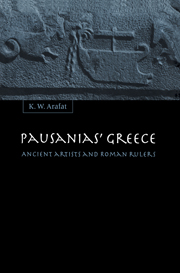Book contents
- Frontmatter
- Contents
- Map of Roman Greece
- Preface and acknowledgements
- List of abbreviations
- Chapter 1 Introduction
- Chapter 2 Pausanias on the past
- Chapter 3 Pausanias on the rulers of Roman Greece 1: introduction, Mummius and Sulla
- Chapter 4 Pausanias on the rulers of Roman Greece 2: Caesar and Augustus
- Chapter 5 Pausanias on the rulers of Roman Greece 3: Nero to Marcus Aurelius
- Chapter 6 Pausanias on Herodes Atticus and other benefactors
- Chapter 7 Conclusions
- Bibliography
- Index of Pausanias passages cited
- Index of other authors and passages cited
- General index
Chapter 2 - Pausanias on the past
Published online by Cambridge University Press: 22 September 2009
- Frontmatter
- Contents
- Map of Roman Greece
- Preface and acknowledgements
- List of abbreviations
- Chapter 1 Introduction
- Chapter 2 Pausanias on the past
- Chapter 3 Pausanias on the rulers of Roman Greece 1: introduction, Mummius and Sulla
- Chapter 4 Pausanias on the rulers of Roman Greece 2: Caesar and Augustus
- Chapter 5 Pausanias on the rulers of Roman Greece 3: Nero to Marcus Aurelius
- Chapter 6 Pausanias on Herodes Atticus and other benefactors
- Chapter 7 Conclusions
- Bibliography
- Index of Pausanias passages cited
- Index of other authors and passages cited
- General index
Summary
The very fact that Pausanias wrote at such length about the sites and monuments of Greece is itself indicative of his most important attitude towards antiquities. That is, that he thought them of sufficient value to be worth recording and, in recording them, he thought it worth travelling extensively in mainland Greece over a period of many years to see them for himself.
Although the context of Pausanias' writings, in the tradition of the periegesis and against the cultural and political background of his day, has been stressed in the previous chapter, analysis of his attitude to antiquities involves greater complexities and subtleties than are accounted for simply by the historical context into which he was born.
J.J. Pollitt has observed that Pausanias ‘almost never expressed personal preferences or values beyond pointing out that certain work was “worth seeing”’. Similarly Habicht, although he argues that Pausanias has been unjustly neglected, gives little space to consideration of the shades of presentation reflected in Pausanias' writings, that is, to how his narrative reflects differing attitudes to specific works and types of works. In contrast, I suggest that Pausanias had strong personal preferences and values in his attitudes to the objects and sites he describes, and that they are reflected in the subtleties of presentation of the objects described in his narrative. It is those attitudes that I hope to define more closely in this chapter.
- Type
- Chapter
- Information
- Pausanias' GreeceAncient Artists and Roman Rulers, pp. 43 - 79Publisher: Cambridge University PressPrint publication year: 1996
- 1
- Cited by

